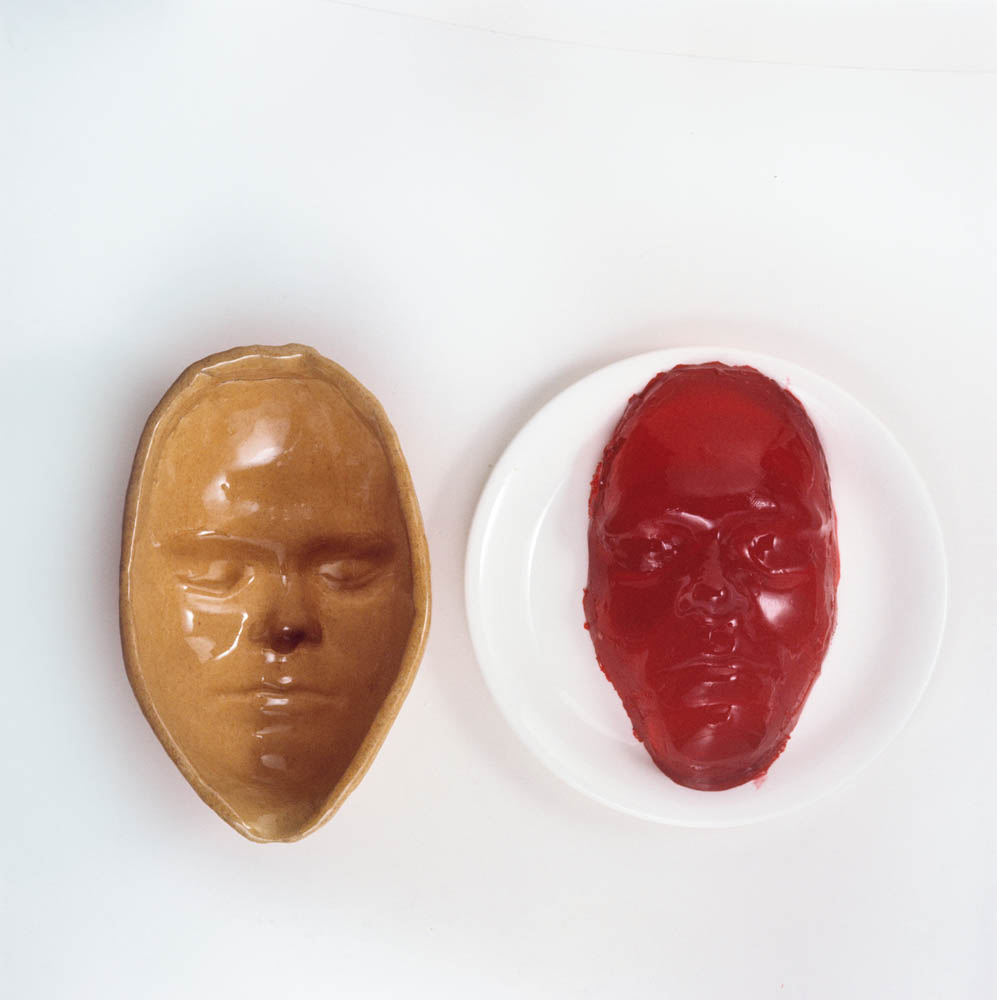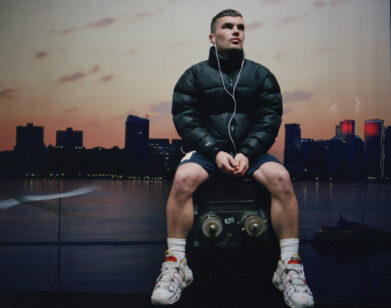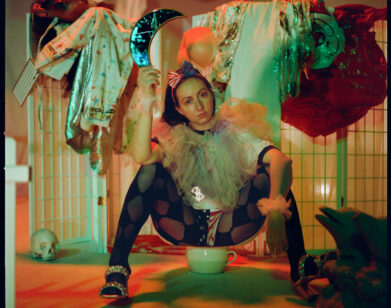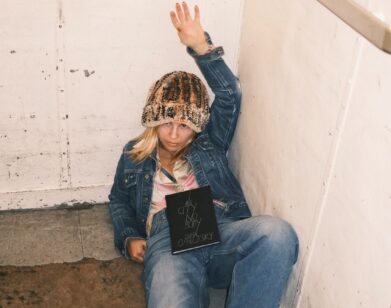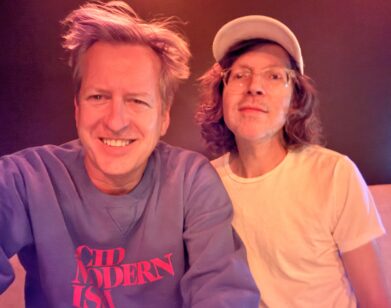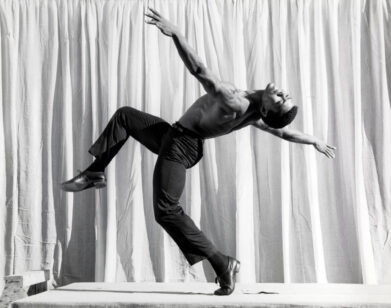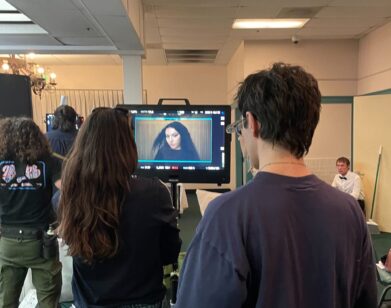Claes Oldenburg
My rule was not to paint things as they were. I wasn’t copying; I was remaking them as my own.claes oldenburg
When I asked Claes Oldenburg where he got his ideas, he said he made them all up as a child. This may seem an outlandish claim, but apparently it’s true. The privileged child of a Swedish diplomat, as a boy he invented a fantasy country called Neubern over which he reigned, designing the urban plan and all its facilities. His exceptional natural talent for drawing immediately brought him attention, but he wanted to do more than draw: He wanted to change the history of art. And he did because not only was he an artist, he was a revolutionary personality.
Oldenburg is one of those rare polymaths who can express themselves in many forms. He has written and published poetry and other texts and created his now legendary theatrical Happenings, in which he appeared as a performer in the early ’60s. He rejected abstract art as conventional and boring and invented a variety of new forms, including installations and the giant soft sculptures that first brought him fame as a pop artist—a term that is too narrow to encompass the range of his activities, from architecture to film. He came up with the radical idea that sculpture was not necessarily hard, like bronze or steel, but could be soft, like cloth or vinyl. The notion came to him when he designed props for his Happenings and environments, which were elaborate sets. The first soft sculptures, in the early 1960s, were giant painted canvas cakes and burgers. These evolved into far more sophisticated household objects, such as giant fans and light switches.
Hailed as an innovation that changed the very definition of the medium, the soft sculptures had no fixed or permanent form. Their configurations were provisional and could be changed at any time, suggesting infinite possible permutations. The viewer’s imagination was provoked, and an even greater intimacy was offered by the fact that the squishy sculptures evoked human body parts. They were not only inventive as new forms done in new materials—women were wearing vinyl mini dresses at the time—they were witty and provocative.
Oldenburg, at age 86, draws constantly, doodling even when in conversation. He’d become fascinated with the idea of public monuments as a child and began to design colossal sculptures for famous public gathering places that he never dreamed would be executed. But when life met art in 1969, the first large-scale monument—Lipstick (Ascending) on Caterpillar Tracks—was actually fabricated as part of the protest against the Vietnam War that had spread to the campus of Yale University, Oldenburg’s alma mater. Students saw the commissioned drawings he was making of a tanklike sculpture and paid to have it fabricated, placing it in front of a campus war memorial in a dramatic confrontation with the authorities. The action proved that his ideas could be realized as public sculptures, and Oldenburg began to receive commissions from cities and museums.
The soft sculptures were sewn by Oldenburg’s first wife, an impish artist and poet named Patty Mucha, whom he met at art school. They separated in the early ’70s, and Oldenburg met the beautiful and brilliant Dutch art historian Coosje van Bruggen, whom he married in 1977. Before van Bruggen’s tragic early death in 2009, they traveled all over the world and collaborated in creating gigantic public sculpture that required advanced technology and great diplomatic skill in navigating political and financial obstacles. Recently friends have been trying to get him to finally realize his project for a giant teddy bear for Central Park, one of his original 1965 Proposed Colossal Monuments. Now as he puts his life and work in order, Oldenburg, in his large SoHo loft, is cleaning up his studio, salvaging writings, drawings, and sculptural maquettes he’s produced throughout his career, some of which he is showing at Paula Cooper Gallery in an aptly named show, “Things Around the House.” As we speak, Oldenburg glances over at the metal maquette of the teddy bear on a shelf, which, if it were ever realized, would change New York forever.
BARBARA ROSE: Claes, when did you decide to become an artist?
CLAES OLDENBURG: I was always interested in drawing. As a child, I started my own country, which was called Neubern. It was located in the South Atlantic. I did the documentation of Neubern in great detail. I drew everything that was there, all the houses and all the cars and all the people. We even had a navy and an air force. I spent a lot of time drawing.
ROSE: What was your position in Neubern?
OLDENBURG: I was the spirit of Neubern. I was the one drawing it. Nobody there knew about me. I was just the creator.
ROSE: A bit like God the Father?
OLDENBURG: Drawing started like that for me. I had no idea what art was. There was one art class in high school, but it didn’t make a big impression on me. Then I went to college and thought I’d become a writer. I studied English and did a lot of reading.
ROSE: You went to Yale.
OLDENBURG: Yes, and when I graduated, I took a job as a newspaper reporter in Chicago.
ROSE: Why Chicago?
OLDENBURG: My father was the Swedish consul there. I grew up in Chicago. My brother and I became Americans there.
ROSE: People often forget that Claes Oldenburg is an American immigrant.
OLDENBURG: I am an immigrant in a sense. What happened was that my father was stationed in New York when my mother became pregnant, and she said, “I’ve got to go to Sweden so this child can be born there, because you don’t have any idea where you’re going to be transferred next.” So I was born in Sweden in 1929, and I was 6 months old when I came back to New York.
ROSE: An anchor baby. But your family is very distinguished. Your brother, Richard, was the director of the Museum of Modern Art. Your father was a diplomat. What did your mother do?
OLDENBURG: My mother was active in Swedish-American affairs and taught singing—opera. Later, she also made abstract art.
ROSE: Since your mother was an abstract artist, why do you never do abstract art?
OLDENBURG: I don’t do abstract art because I don’t find it as interesting as I do subjects and depictions.
ROSE: Well, some of your sculptures, the hard versions, can be read as geometric abstractions.
OLDENBURG: When you’re working with an object, you can put in almost anything you want, you can make it abstract. Anyway, after working as a reporter at the City News Bureau in Chicago for a year and a half, I was called up for the draft. The Korean War was on at the time. I thought, “This is the end.” One of my best friends had just been killed over there. So I went and had my examination and wasn’t accepted.
ROSE: Do you know why?
OLDENBURG: I was just a bit older at that point. They were taking kids who were 17. It also might have been because of my flat feet. And that I appeared a little unreliable.
ROSE: That’s why Frank Stella was turned down by the Army, for reasons of that nature: physically defective and unreliable.
OLDENBURG: I thought I could do more for the country if I did something here. I went for walks along Lake Michigan thinking about it. I knew I wasn’t that good a writer, and all I could remember was that I could draw. I’m better at drawing than I am at writing.
ROSE: Many people, including me, would say you’re the great draftsman of your generation. In fact, you’re the only one who really has an immense natural talent for drawing.
OLDENBURG: I got a little studio in Chicago and practiced. I realized I had to earn some money. So I went to work for an advertising agency where my job was mostly drawing insects for a company that sold an insecticide spray. That went on for a while. I knew I had to take my ambition more seriously, so I enrolled at the Art Institute of Chicago. Then, in the fall, I went on a tour of my own. I didn’t go to New York because that was too well known for its art scene. But there was the rest of America. So I got on a bus and went to New Orleans, Houston, Los Angeles, San Francisco. This was in 1953. Nothing was happening in these cities except San Francisco. I remember going into a newly opened bookshop called City Lights. Things were heating up in San Francisco. The landscape was beautiful, the music terrific, and the art original. So I stayed there. I got a job as a dishwasher in Oakland, and I would draw all day. It was nice because the lady who ran the boardinghouse where I worked let me live there for nothing if I gave her some drawings every week—mostly park drawings of birds and such. And then, at the end of that year, I had to return to Chicago because I had to get my citizenship papers. In the spring of 1954, I went back to the Art Institute, then spent the summer at the Ox-Bow School in Saugatuck, Michigan. That’s what really awakened me. I made a lot of oil paintings and my first performance.
“As a child, I started my own country. It was located in the South Atlantic. I drew everything that was there, all the houses and all the cars and all the people. We even had a navy and an air force. CLAES OLDENBURG
ROSE: Why did you do your first performance there? Because everyone thinks performance began in John Cage’s classes at the New School in New York.
OLDENBURG: This is a different branch. I remember the first performance involved a raft on the water, which we sank. Ox-Bow was a very free place, very open. You could do whatever you wanted to do. After that, I did another stint at the Art Institute, decided it was too conservative, and set up my own studio. I just started to do my own thing for about a year and a half, and I worked in the evening selling phonograph records. Then I said to myself, “I’m afraid I have to go to New York after all.” [laughs]
ROSE: You met some important friends in Chicago.
OLDENBURG: Yes, like H.C. Westermann, George Cohen, and Marjorie Oplatka, who got me into Freud and dream analysis. I turned in a completely different direction.
ROSE: Well, the images you use stem from a kind of process of free association, which is Freudian. You’ll have an idea and then that will call to mind other ideas.
OLDENBURG: Yes. And you can take an object and simply put anything you want in that object, and I accessed that partly through Freudian ideas. So finally I took off for New York and arrived there by bus, once again, on May 31, 1956.
ROSE: Who were the first people you met in New York?
OLDENBURG: The only person I knew was Robert Indiana, with whom I had shown in Chicago. He told me to go to the Cedar Bar, because that’s where I’d meet everyone. It was easy to get a job at the Cedar Bar because people came and went, but I didn’t like the atmosphere. Instead, I got a job at Cooper Union Library. I stayed at Cooper Union for seven years; it was my salvation. While I worked there, I also read books of every kind.
ROSE: Where were you living?
OLDENBURG: I was living in odd little places here and there, searching for the right one.
ROSE: It’s more crashing than living.
OLDENBURG: I would go out and buy newspapers and magazines and do cutouts and clippings. In 1958 I finally found a large enough apartment on the Lower East Side, where I reverted to figure painting. I drew and painted quite a lot of figures and nudes. People would come and pose for me. Gerd Muehsam, a librarian at Cooper Union, suggested I show my drawings at the art school library. I showed them and they were well received. Tom Wesselmann and Marcus Ratliff, who were both students, said, “We’re starting a gallery at the Judson Church. Would you like to come and be part of it?” I said, “Sure.”
ROSE: Because in those days, the galleries were cooperatives. In other words, the Hansa Gallery was a cooperative. The artists made cooperatives to show their work.
OLDENBURG: And Judson Church was a very important place because they believed in art. They also took care of drug addicts. Without the Judson, nothing could have happened.
ROSE: The minister of that church, Howard Moody, was very welcoming. The Happenings were done there, the dances, all the early choreography, like Yvonne Rainer. And there were performances. You did performances there, right?
OLDENBURG: Yes. They asked me to do a show, and I was planning on showing my figure paintings. But my friends told me I shouldn’t—the paintings were good but a little old-fashioned. They said, “Why don’t you show the other stuff?” I had also been making rather strange objects, more in the Freudian tradition.
ROSE: For example?
OLDENBURG: There was a coat rack that I had changed into a sculpture called Lady and several other sculptures I had created directly out of wood. So that’s what I showed instead—and that was the beginning of my activity as an artist.
ROSE: You were married twice and had very important creative relationships with your wives. Patty Mucha, a painter and a poet, and Coosje van Bruggen, who was a Dutch art historian and writer. Now, how did you meet Patty?
OLDENBURG: I first met her at Ox-Bow, and then I’d see her around New York. She lived with Olga Adorno.
ROSE: Oh, yes. Olga Adorno was this very beautiful Puerto Rican dancer and nightclub singer. She was extremely glamorous—she was like a movie star.
OLDENBURG: I painted her.
ROSE: She was fabulous, gorgeous, far grander than our little dinky world. But all of this goes to say that, at that time, there was a climate for performance, of people dressing up for each other, for parties or happenings or whatever.
OLDENBURG: Oh, sure. The art world was very small and the people got together at parties. There was less commercialism.
ROSE: There was no money. We were outcasts. We had to get together because we didn’t know anybody else. You were the person who said to me, “SoHo’s like a college campus; you just walk out on the street and you bump into someone.” And it’s true; everybody who lived in SoHo in the beginning knew each other. And there were no services, there was nothing.
OLDENBURG: Only a couple of restaurants.
ROSE: What nobody understands is that the world of the artists in the late ’50s and early ’60s was completely apart, its own little cosmos, like Montmartre or Montparnasse. You had nothing to do with anyone except other artists. Then the civilians began to come, and it was over.
OLDENBURG: You formed little groups. And those groups sort of watched each other.
ROSE: Everybody really knew each other; the people who went to the Judson performances were the same people who went to La Monte Young’s concerts.
OLDENBURG: I was very happy to be living in New York at that time, more than in the present time. Now it’s all commerce.
ROSE: There was a sense of community. You had to take care of these other displaced, alienated, hopeless people who couldn’t hold down an office job. You really couldn’t do anything that the world wanted, so you took care of each other. It was like a huge dysfunctional family.
OLDENBURG: And the groups formed naturally into the new art scene. Because when I arrived, there was still some confusion about where we were going after abstract expressionism.
ROSE: Or are we going anywhere?
OLDENBURG: What happened then with the influx of certain artists, including myself, is that a new type of art developed, which became the art of Allan Kaprow, Jim Dine, Bob Whitman, and Lucas Samaras. That was a pretty formidable group.
ROSE: Yes, a very experimental group. We live today in a risk-averse culture. Everybody’s terrified of everything. Back then, we were scared of nothing because we had nothing to lose.
OLDENBURG: And the money situation was so different. You paid very little for your apartments. I had an apartment with five rooms and it was 60 dollars a month.
ROSE: Claes, you are often associated with the pop artists and, of course, Andy Warhol. But it’s interesting to note that you haven’t mentioned the pop artists as the early group you formed in New York.
OLDENBURG: Andy was on the scene, but he wasn’t an artist at first; he was more an illustrator. He was always surrounded by about ten people who worshipped him. He’d go to a party and they would all come along. But he was drawing shoes and that sort of thing. His work as an artist came a bit later.
ROSE: Didn’t you end up in Los Angeles with Warhol for a brief time?
OLDENBURG: Yes, in 1963. I had gone to Los Angeles to make a show with Virginia Dwan. Andy was coming to Los Angeles for the first time to do a show with Irving Blum. We happened to arrive at the same moment. I stayed in L.A. long enough to further develop soft sculpture using materials from a wonderful store of remnants called Lincoln Fabrics.
ROSE: Why did you conceive of making sculptures soft?
OLDENBURG: I got very infatuated with vinyl. But really, the soft stuff comes out of Happenings, because of the costumes and props that Patty would sew. She continued to sew the soft sculptures for me. I would conceive and design them, and we would translate them into patterns. The first big ones were the cake, the cone, and the hamburger. One day a red convertible pulled up outside our cottage and it was Sidney Janis. He said, “How’d you like to join my gallery?” All the abstract artists were leaving the gallery, and he was substituting our group.
ROSE: And suddenly the term “pop art” was invented.
OLDENBURG: It had been kicking around, but it hadn’t become enshrined.
ROSE: I remember one of the first articles I wrote was called “Dada Then and Now,” because people thought this work was Dada, which was not true.
OLDENBURG: My work doesn’t have the same rules as, say, Andy’s work. But it’s gathered together for the simple reason that we all worked with the images and objects around us.
ROSE: They were recognizable objects. And there was also a democratic urge, I believe. Even if the audience didn’t understand the aesthetic properties, they could recognize the subject of the work. Artists wanted people in some way to be able to recognize things. You mentioned your rules. What were they?
OLDENBURG: My rule was not to paint things as they were. I wasn’t copying; I was remaking them as my own.
ROSE: True, the objects didn’t look like the objects that inspired them.
OLDENBURG: Some of the works do have very strong pop art elements—like the Bedroom Ensemble [1963].
ROSE: That work was amazing! It was like a motel bedroom, the whole thing installed at the Sidney Janis Gallery. But back to the invention of soft sculpture—one of the extraordinary elements of soft sculpture was that it could be rearranged in many different positions, that it’s not stable, that it has permutations, that you can imagine it in other positions, or that it can assume different configurations.
OLDENBURG: Every day, you can change it.
ROSE: This was an enormous invention, as was the fact that it’s no longer this traditional bronze material. It was the reinvention of sculpture, really.
OLDENBURG: Of course, Duchamp does come into it. Duchamp is known for calling a thing art, rather than making it. A lot of that is picked up in pop art, too—by Andy, for example. But I’m always careful to say that I changed everything I found. So that was the big difference. Mine was not pop art. I maybe started with a subject, but I changed the subject.
ROSE: There’s always a transformation.
OLDENBURG: And lots of things were injected into it from my mind and my feelings, which is not true with most of Duchamp’s work.
ROSE: He wanted to be impersonal, and most of your work is very personal. I’m thinking of all the self-portraits you made in different materials. The one I like best is the jello mold of your face—so that you could be served. And it was served at a dinner party back in 1968. You could eat Claes’s face, if you wanted to.
OLDENBURG: Irving Blum had the opening. We had about 50 of them in different colors all lined up.
I don’t do abstract art because I don’t find it as interesting as I do subjects and depictions . . . When you’re working with an object, you can put in almost anything you want. claes oldenburg
ROSE: The art/life relationship for you is different than it is for other artists. I remember Donald Judd really hated pop art, but he liked your work.
OLDENBURG: We traded pieces.
ROSE: You fit into his category of “specific objects.” He wanted art to be a literal three-dimensional object and not an illusion of something that you saw. So you are the one “pop artist,” which is, again, a category that’s not real, that Don felt was close to his aesthetic, or that he could get enthusiastic about.
OLDENBURG: Yes. In the mid-’60s, I started to draw buildings. I called them Proposed Colossal Monuments—they weren’t for real, not for actual building. It was more a critique of architecture. That was the first step. And then I started to play around with the possibility of making pieces in an architectural form.
ROSE: You did that painting of pills for the wall beside the Museum of Contemporary Art in Chicago. And Chicago is the city of architecture. It has struck me that a lot of the subject matter of your work involves food or consumption.
OLDENBURG: I like food because you can change it. I mean, there is no such thing as a perfect lamb chop; you can make all types of lamb chops. And that’s true of everything. And people eat it and it changes and disappears.
ROSE: Consumption is also primitive; it’s Paleolithic. And yet we’re in this culture where everybody’s consuming everything.
OLDENBURG: Food is like clay; you can sculpt with it. Also it has an odor, and you can eat it. I don’t eat a lot of cake, but I do make cakes! And unlike the Campbell’s Soup Cans, my food is a humanized form and scale.
ROSE: I think that’s very important about your work, the human quality. It’s always the human shape or the human process. It’s far more rooted in a humanist tradition, shall we say. It’s not industrial.
OLDENBURG: Well, you can make industrial things, too.
ROSE: You made a molded polyurethane relief of a car—the Chrysler Airflow relief [Profile Airflow, 1969].
OLDENBURG: But even those are basically imitations of what you would do by hand.
ROSE: Let’s talk about the monuments. Because those have to be realized through industrial fabrication.
OLDENBURG: It came out of the chapter of the Proposed Colossal Monuments. There was a giant ironing board, for example, for the Lower East Side. Actually, New York is great for playing around. I made a lot of studies for New York-a big vacuum cleaner lying on the Battery in Manhattan.
ROSE: And then there’s that self-portrait of you, where you have the ice bag on your head. And you did do the kinetic Giant Ice Bag [1969-70]. But I’ve always looked at that self-portrait of you with the ice bag on your head and tears streaming down and thought that it’s Pagliacci, the laughing, crying clown.
OLDENBURG: In the drawing, I am genial on one side of the face and angry on the other.
ROSE: I love the ice bag. It’s like you have a headache. And there was a period in which there was a lot of, shall we say, hangover situations requiring ice bags.
OLDENBURG: Oh, yes, it was very common in comic strips.
ROSE: Of course, everybody takes drugs now. But back then, artists didn’t really do drugs.
OLDENBURG: No, it was drinking. Of course, the ’60s was a study in decadence. Everything just got worse and worse, and at the end of the ’60s, everything was so horrible that people were killing each other.
ROSE: We were killing each other all over the place—Vietnam, assassinations, race riots.
OLDENBURG: The end of the ’60s was a terrible time. I was in Los Angeles then, and I remember the night someone ran into the studio and told us about the Manson murders. Then suddenly something happened, the ’60s disappeared. The ’70s were completely different.
ROSE: Yeah, it all crashed out.
OLDENBURG: Patty and I got divorced. I rented an abandoned factory in North Haven, Connecticut, and started to make different things. Pornography became very popular and acceptable.
ROSE: The first one of your monuments that was realized had to do with the antiwar movement in 1969. The students of Yale actually paid for this first monument, which was Lipstick (Ascending) on Caterpillar Tracks. It’s a tank.
OLDENBURG: It’s a tank, but it could also double as a Caterpillar tractor. The original idea was that someone who wanted to make a speech could climb on the tank and operate a lever that would inflate the lipstick to draw attention. If the speaker stopped pumping, the lipstick would deflate. So while you’re talking enthusiastically about the issues of the day, meanwhile, it’s going down. For lack of funds, the lever was abandoned and the lipstick stood permanently raised.
ROSE: It was built at the high watermark of campus protests. And the university was terrified. But it was the students who demanded this piece be erected—they paid for it to be put on the campus in front of the war memorial. Fortunately, Yale had Kingman Brewster, a very enlightened president. The campus was a tinderbox.
OLDENBURG: It was [Yale architectural historian] Vincent Scully who convinced Brewster that he should leave it alone. He said, “Let it happen, otherwise, it’s going to be a terrible disaster.” So that was wonderful. Then the sculpture started to decay bit by bit, and finally I took it away, because it was a wreck. It stood in the Lippincott factory for several years, and then in 1974 other enlightened people came into the art department, and they wanted to restore it and put it in a proper situation. Eventually, the sculpture was placed in Morse College. And there it still stands, and it has now been declared part of the Yale art collection, which took many, many years.
ROSE: What were the next monuments that were made?
OLDENBURG: The Geometric Mouse, of which I made six.
ROSE: How big were they?
OLDENBURG: They’re measured by the ear; this set had a six-foot ear. Really big. It would fill this whole room. The mouse was commissioned by MoMA, but they reneged on their commission. Later on, they bought a white version. Then came the Giant Three-Way Plug [1970] for Oberlin.
ROSE: These are all well over life-size.
OLDENBURG: Oh, yes, and they kept getting larger. The first architectural-scale sculpture came in 1976 with the Clothespin in Philadelphia.
ROSE: It’s a masterpiece. It has obvious anthropomorphic associations, but the fact that it was realized is a miracle. There was a lot of back and forth, right? Because once you get into public art, you’re involved with politicians. And once you’re involved with politicians, you have a nightmare. But you had people on your side, like Joan Mondale, the wife of Walter Mondale.
OLDENBURG: The reason this got done is because Philadelphia is one of the few cities that make you set aside a certain amount for art if you’re going to build a building. We were so lucky to be in that period.
ROSE: The government had instituted a program called Art in Architecture. One half of one percent of the construction costs of social security buildings or courthouses had to go toward art. Now, here’s the problem: Once the politicians become involved, it’s over. But in the beginning, experts—art-world professionals, art historians, or museum curators—selected the artists. I think what finally happened much later was Richard Serra’s Tilted Arc [1981] made people realize how terrible the architecture was, because you had to look at it. Nobody ever looked at the buildings. And all of a sudden, they saw this terrible inhuman building. So they started hiring architects who could build decent buildings that we could be proud of. Luckily, you continued making your public monuments.
OLDENBURG: The Philadelphia Clothespin was really the beginning of that period. Later, in ’76, Coosje and I selected the color of the next public sculpture, the 100-foot Batcolumn [1977] for Chicago. I had wanted to make it red, but she said, “There is a big red Alexander Calder downtown, so why don’t we make it a different color? Besides, red is not a Chicago color; Chicago is all gray.” So we found our special gray, which worked out well. Now many buildings have been built around the piece, and it really harmonizes with them. When we started, the area was known as Skid Row.
ROSE: You and Coosje began to travel a lot.
OLDENBURG: We did. We began accepting projects in Germany, France, Italy, the U.K., and even acquired a castle in the center of France to operate from. We also made projects for Japan and South Korea. And, of course, a number of works all over the U.S., a total of 42 large-scale projects. The Kreysler factory, north of San Francisco, showed us that works could be made to look soft by using fiberglass. That was the beginning of a whole new approach. The first one we did in fiberglass was the Inverted Collar and Tie in 1994 in Frankfurt, Germany.
ROSE: What’s the most recent colossal sculpture you’ve done?
OLDENBURG: The Paint Torch in Philadelphia, which went up in 2011 beside the Pennsylvania Academy of the Fine Arts.
ROSE: Are you still seeing the Freudian implications in these monumental objects?
OLDENBURG: Well, I think the Freudian impulse is in everything, so I just accept it. I don’t always believe what Freud is saying but it sounds like fun. [laughs]
ROSE: Freud defines impulse as Eros and Thanatos: sex and death. Now, you did go through a long erotic phase. We really should talk about your erotic work.
OLDENBURG: Oh, there’s always been a potential erotic possibility with objects.
There is no such thing as a perfect lamb chop; you can make all types of lamb chops. And that’s true of everything. And people eat it and it changes and disappears. claes oldenburg
ROSE: But there are orgy drawings, for example. Your orgy drawings are very interesting. Did you ever go to an orgy?
OLDENBURG: No.
ROSE: I didn’t think so. Would you like to?
OLDENBURG: No, not particularly.
ROSE: Why?
OLDENBURG: It’s also a little bit late for me at this point.
ROSE: Well, there are different ways of participating. [laughs] I knew a lot of people who went. It seemed a boring idea to me. Anyway, would you make a distinction between the erotic and the pornographic?
OLDENBURG: No. The sexual is part of everything, and it’s highly formalized. I hadn’t done figure for a long time. And I thought to myself, “Why not the erotic figure?”
ROSE: I just thought of something. There’s a lot of sex in your work but what about death? By and large, there’s not much of the death instinct in your work.
OLDENBURG: No, maybe not. Although my Happenings all ended with everybody perfectly still.
ROSE: That’s true. I forgot about that. Yes, your performances were highly structured. The one I was in, which is called Washes [1965], was done in a swimming pool. And you did a very famous installation that was called The Store [December 1, 1961-January 31, 1962], where you actually sold things.
OLDENBURG: It was on Second Street off First Avenue.
ROSE: Performances were done in The Store, but only 37 people could get into The Store.
OLDENBURG: Remember the thrill clubs? People who lived out on Long Island who went into New York for fun would get into these thrill clubs, and part of it was that the club would take them to see a Happening. They would come to The Store and watch, and as far as they were concerned, nothing happened. And then they would file out. It was a dollar to get in. I gave them their dollars back as they were going out. They just didn’t get it.
ROSE: Again, the art world was in opposition to this commercial bourgeoisie world. People wanted to make successful art, but I don’t think anybody wanted to be a “success.” And it wasn’t even a possibility. Now, am I remembering correctly that you did a drawing for Frank O’Hara? He was so fabulous, so enthusiastic and supportive.
OLDENBURG: After Frank died, I contributed a print to his memorial portfolio, pairing a composite image of a teapot, an elephant, and a Buddha with one of his poems.
ROSE: You’ve said you see your life in chapters. Your life changed radically when you met Coosje.
OLDENBURG: The chapter with Coosje started in ’76 and ’77. We moved to Holland in the beginning of ’77 and got married in Michigan that summer, when the Mouse Museum [1965-77] was being built in Chicago. I had, over the years, collected things, small things, as people do, and I had put them all together and showed them in what became a building in the form of the Geometric Mouse.
ROSE: Mickey Mouse, the Disney creation, is the symbol of America; it’s the symbol of American popular culture. But you made the mouse into a building that adults can enter. And inside was your whole collection of stuff. Not to be confused with your Ray Gun Wing [1977], with objects you found that look like guns. And America is all about guns.
OLDENBURG: I always knew America was all about guns. You go to the movies as a kid, everybody’s got a gun.
ROSE: Of course, the ray gun could also be about death.
OLDENBURG: The thing about the ray gun is, you pick up anything you see on the street that’s the shape of a gun. But I’ve got to tell you whether it’s a ray gun or not, because I’m the authority. So if you find one on the street, you’ve got to bring it to me to be certified. I’ve stopped collecting them myself. It’s too complicated because everything is a ray gun. It never stops because the right angle is one of the world’s basic shapes.
ROSE: Do you remember when I took you to a psychic once? You were going through a period of some confusion and needed advice. The psychic’s name was Doris, and she worked out of the Roundtable. I took Bob Morris to her and also Jasper Johns. You went up and came back and I said, “What’d she say?” You were there a long time. You said, “Well, she looked at my hand and said, ‘I don’t know what you do, darling, but it’s very soft. And there will be a piece of you in every great city in the world.’â??” Remember she said that?
OLDENBURG: Yes!
ROSE: You had no idea what she was talking about. Because this was before you’d done any of the monuments.
OLDENBURG: You’re absolutely right—a piece in every city. What a brilliant thing she said.
ROSE: But so far, there is nothing in New York, so tell me about your potential teddy bear monument for Central Park. The original drawing was one of the first Proposed Colossal Monuments.
OLDENBURG: Several people have suggested actually building the piece, and I have pointed out to them that the drawings show it the way it should be—very big. To make it that large would be to make it as large as a 20-story building.
ROSE: Anything’s possible.
OLDENBURG: That’s what they tell me!
BARBARA ROSE IS AN ART HISTORIAN AND CURATOR. SHE IS CURATING THE UPCOMING SHOW “INSIDE OUT,” FEATURING ARTISTS MARTIN KLINE AND MELISSA KRETSCHMER, AND IS FINISHING A BOOK ON THE MOZARBIC BEATUS APOCALYPSE MANUSCRIPTS AND THEIR INFLUENCE ON MODERN ART.

